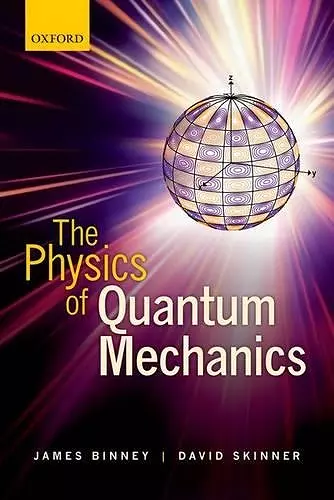The Physics of Quantum Mechanics
David Skinner author James Binney author
Format:Paperback
Publisher:Oxford University Press
Published:31st Oct '13
Should be back in stock very soon
This paperback is available in another edition too:
- Hardback£90.00(9780199688562)

The Physics of Quantum Mechanics aims to give students a good understanding of how quantum mechanics describes the material world. It shows that the theory follows naturally from the use of probability amplitudes to derive probabilities. It stresses that stationary states are unphysical mathematical abstractions that enable us to solve the theory's governing equation, the time-dependent Schroedinger equation. Every opportunity is taken to illustrate the emergence of the familiar classical, dynamical world through the quantum interference of stationary states. The text stresses the continuity between the quantum world and the classical world, which is merely an approximation to the quantum world. The connections between observables, operators and transformations are clearly explained and the standard commutation rules derived from the properties of spacetime. A chapter is devoted to entanglement, quantum computation, density operators and their role in thermodynamics, and the measurement problem. Scattering phenomena, including the origin of radioactivity, are handled early on in the accessible context of one dimension, and at the end of the book with some rigour in three dimensions. Hydrogen and helium are discussed in some detail and it is shown that quantum mechanics enables us to understand the structure of the periodic table without engaging with the complexities of many-electron atoms. Dirac notation is used from the outset and students are trained to move easily from one representation to another, choosing whichever representation is best suited to a particular problem. The mathematical prerequisites are no more than simple vector algebra, Taylor series expansion and the use of integrating factors to solve linear first order differential equations. Rigorous algebraic methods are preferred to the solution of partial differential equations.
This book is a deep, well-explained and beautiful text on the foundations and applications of quantum mechanics. It is eminently suitable for advanced undergraduates and graduates who wish to study the subject. Some precious jewels can be found within after building up the Dirac representation of quantum mechanics: scattering theory and condensed matter applications, for example. * Ben Allanach, Department of Applied Mathematics and Theoretical Physics, University of Cambridge *
The extensive discussion of the physics behind the mathematical manipulations of the theory, coupled with the smooth, colloquial writing style and delightful historical footnotes makes this book somewhat unique in the field. It devotes large sections to the more modern topics of quantum computing and quantum measurement theory, which are active areas of current research. In addition, there is a copious selection of problems, at all levels of difficulty, which should prove extremely useful to anyone teaching the course. * Harold S. Zapolsky, Rutgers University *
Binney and Skinners introductory book on quantum mechanics approaches the subject in a unique way ... The text is very well written for the target audience of second or third year University students in Physics, Chemistry, or certain Engineering specialties and I would highly recommend it for anyone who might be considering teaching or tutoring such a course. * Brian Todd Huffman, University of Oxford *
ISBN: 9780199688579
Dimensions: 234mm x 156mm x 23mm
Weight: 620g
416 pages